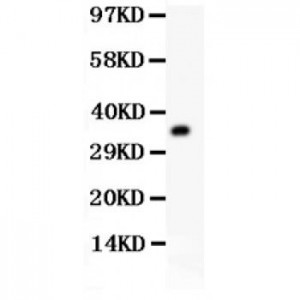More info
Overview
Long Name | Antibody Type | Antibody Isotype | Host | Species Reactivity | Validated Applications | Purification |
| guanine nucleotide binding protein (G protein), beta polypeptide 2-like 1 | Polyclonal | IgG | Rabbit | Human, Mouse, Rat | WB | Immunogen affinity purified. |
Immunogen | ||||||
| E.coli-derived human RACK1 recombinant protein (Position: T2-R317). Human RACK1 shares 100% amino acid (aa) sequence identity with both mouse and rat RACK1. | ||||||
Properties
Form | Lyophilized |
Size | 100 µg/vial |
Contents | Antibody is lyophilized with 5 mg BSA, 0.9 mg NaCl, 0.2 mg Na2HPO4, 0.05 mg NaN3. *carrier free antibody available upon request. |
Concentration | Reconstitute with 0.2 mL sterile dH2O (500 µg/ml final concentration). |
Storage | At -20 °C for 12 months, as supplied. Store reconstituted antibody at 2-8 °C for one month. For long-term storage, aliquot and store at -20 °C. Avoid repeated freezing and thawing. |
Additional Information Regarding the Antigen
Gene | GNB2L1 |
Protein | Guanine nucleotide-binding protein subunit beta-2-like 1 |
Uniprot ID | P63244 |
Function | Involved in the recruitment, assembly and/or regulation of a variety of signaling molecules. Interacts with a wide variety of proteins and plays a role in many cellular processes. Component of the 40S ribosomal subunit involved in translational repression. Binds to and stabilizes activated protein kinase C (PKC), increasing PKC-mediated phosphorylation. May recruit activated PKC to the ribosome, leading to phosphorylation of EIF6. Inhibits the activity of SRC kinases including SRC, LCK and YES1. Inhibits cell growth by prolonging the G0/G1 phase of the cell cycle. Enhances phosphorylation of BMAL1 by PRKCA and inhibits transcriptional activity of the BMAL1-CLOCK heterodimer. Facilitates ligand- independent nuclear translocation of AR following PKC activation, represses AR transactivation activity and is required for phosphorylation of AR by SRC. Modulates IGF1R-dependent integrin signaling and promotes cell spreading and contact with the extracellular matrix. Involved in PKC-dependent translocation of ADAM12 to the cell membrane. Promotes the ubiquitination and proteasome-mediated degradation of proteins such as CLEC1B and HIF1A. Required for VANGL2 membrane localization, inhibits Wnt signaling, and regulates cellular polarization and oriented cell division during gastrulation. Required for PTK2/FAK1 phosphorylation and dephosphorylation. Regulates internalization of the muscarinic receptor CHRM2. Promotes apoptosis by increasing oligomerization of BAX and disrupting the interaction of BAX with the anti-apoptotic factor BCL2L. Inhibits TRPM6 channel activity. Regulates cell surface expression of some GPCRs such as TBXA2R. Plays a role in regulation of FLT1-mediated cell migration. Binds to Y.pseudotuberculosis yopK which leads to inhibition of phagocytosis and survival of bacteria following infection of host cells. Enhances phosphorylation of HIV-1 Nef by PKCs. Promotes migration of breast carcinoma cells by binding to and activating RHOA. |
Tissue Specificity | In the liver, expressed at higher levels in activated hepatic stellate cells than in hepatocytes or Kupffer cells. Up-regulated in hepatocellular carcinomas and in the adjacent non-tumor liver tissue. |
Sub-cellular localization | Cell membrane; Peripheral membrane protein. Cytoplasm. Cytoplasm, perinuclear region. Cytoplasm, cytoskeleton. Nucleus. Perikaryon . Cell projection, dendrite . Cell projection, phagocytic cup. Note: Recruited to the plasma membrane through interaction with KRT1 which binds to membrane-bound ITGB1. Also associated with the membrane in oncogene-transformed cells. PKC activation induces translocation from the perinuclear region to the cell periphery. In the brain, detected mainly in cell bodies and dendrites with little expression in axonal fibers or nuclei. Localized to phagocytic cups following infection by Y.pestis. |
Sequence Similarities | Belongs to the WD repeat G protein beta family. |
Aliases | Cell proliferation-inducing gene 21 protein antibody|GBLP_HUMAN antibody|Gnb2 rs1 antibody|Gnb2-rs1 antibody|GNB2L1 antibody|Gnb2rs1 antibody|Guanine nucleotide binding protein (G protein) beta polypeptide 2 like 1 antibody|Guanine nucleotide binding protein beta polypeptide 2 like 1 antibody|Guanine nucleotide binding protein beta subunit 2 like 1 antibody|Guanine nucleotide binding protein beta subunit like protein 12.3 antibody|Guanine nucleotide binding protein subunit beta 2 like 1 antibody|Guanine nucleotide binding protein subunit beta like protein 12.3 antibodyGuanine nucleotide-binding protein subunit beta-2-like 1 antibody|Guanine nucleotide-binding protein subunit beta-like protein 12.3 antibody|H12.3 antibody|HLC 7 antibody|HLC-7 antibody|HLC7 antibody|Human lung cancer oncogene 7 protein antibody|Lung cancer oncogene 7 antibody|OTTHUMP00000223704 antibody|OTTHUMP00000223870 antibody|OTTHUMP00000223891 antibody|OTTHUMP00000223893 antibody|OTTHUMP00000223900 antibody|OTTHUMP00000223902 antibody|OTTHUMP00000223930 antibody|OTTHUMP00000223931 antibody|PIG 21 antibody|PIG21 antibody|Proliferation inducing gene 21 antibody|Protein homologous to chicken B complex protein guanine nucleotide binding antibody|RACK 1 antibody|RACK1 antibody|Receptor for activated C kinase antibody|Receptor for activated C kinase 1 antibody|Receptor of activated protein kinase C 1 antibody |
Application Details
| Application | Concentration* | Species | Validated Using** |
| Western blot | 0.1-0.5μg/ml | Human, Mouse, Rat | AssaySolutio's ECL kit |
AssaySolution recommends Rabbit Chemiluminescent WB Detection Kit (AKIT001B) for Western blot. *Blocking peptide can be purchased at $65. Contact us for more information

Anti- RACK1 antibody, ASA-B1605, Western blotting
All lanes: Anti RACK1 (ASA-B1605) at 0.5ug/ml
WB: Recombinant Human RACK1 Protein 0.5ng
Predicted bind size: 35KD
Observed bind size: 35KD
All lanes: Anti RACK1 (ASA-B1605) at 0.5ug/ml
WB: Recombinant Human RACK1 Protein 0.5ng
Predicted bind size: 35KD
Observed bind size: 35KD

Anti- RACK1 antibody, ASA-B1605, Western blotting
All lanes: Anti RACK1 (ASA-B1605) at 0.5ug/ml
Lane 1: Mouse Liver Tissue Lysate at 50ug
Lane 2: Rat Spleen Tissue Lysate at 50ug
Lane 3: Mouse Spleen Tissue Lysate at 50ug
Lane 4: SMMC Whole Cell Lysate at 40ug
Lane 5: HEPG2 Whole Cell Lysate at 40ug
Lane 6: HEPA Whole Cell Lysate at 40ug
Lane 7: RH35 Whole Cell Lysate at 40ug
Predicted bind size: 35KD
Observed bind size: 35KD
All lanes: Anti RACK1 (ASA-B1605) at 0.5ug/ml
Lane 1: Mouse Liver Tissue Lysate at 50ug
Lane 2: Rat Spleen Tissue Lysate at 50ug
Lane 3: Mouse Spleen Tissue Lysate at 50ug
Lane 4: SMMC Whole Cell Lysate at 40ug
Lane 5: HEPG2 Whole Cell Lysate at 40ug
Lane 6: HEPA Whole Cell Lysate at 40ug
Lane 7: RH35 Whole Cell Lysate at 40ug
Predicted bind size: 35KD
Observed bind size: 35KD



